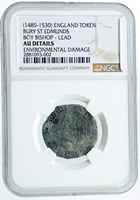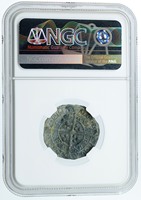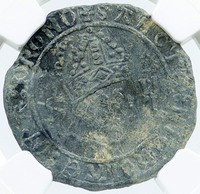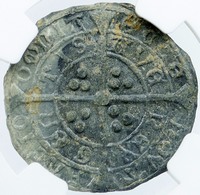England. Bury St. Edmunds
St. Nicholas Feast 'Boy Bishop' Series
1485-1530 Lead Token 24mm (4.93 grams)
Time of King Henry VII–Henry VIII.
Cast at Bury St. Edmund's.
Reference: Mitchiner & Skinner II, group Pi, 1.
Certification: NGC AU DETAILS 2881093-002
SΛNCTЄ : NIChOLΛЄ : ORΛ : PRO : NO, boy's head facing slightly right, wearing bishop's mitre; croziers with letters S and И flanking / ЄCCЄ NOVΛ FACIO OmNIΛ/ ΛVЄ RЄX GЄnTIS, long cross pattée; triple pellets in quarters. Britain in the late middle ages played host to a popular regional variant of the 'Feast of Fools' festival. Every year on the feast of St. Nicholas, a boy was elected from among the local choristers to serve as 'bishop.' Dressed in mitre and bearing the croizer of his office, the young boy paraded through the city accompanied by his equally youthful 'priest' attendants. The 'bishop' performed all the ceremonies and offices of the real bishop, save for the actual conducting of mass. Though this practice was extinguished with the Dissolution of the Monasteries in 1539, it was briefly revived under Queen Mary, who took particular interest in the festival, when the lucky boy was referred to as 'Queen Mary's Child.' The celebration of the boy bishop died out completely early in the reign of Elizabeth. Evidence of this custom is particularly prevalent in East Anglia, specifically at Bury St. Edmunds. Beginning in the late 15th century, the region produced numerous lead tokens bearing the likeness of a bishop, often bearing legends relating to the festival of St. Nicholas. Issued in sizes roughly corresponding to groats, half groats, and pennies, these pieces were undoubtedly distributed by the boy bishop himself, and were likely redeemable at the local abbey or guild for treats and sweetmeats. Considering the endemic paucity of small change in Britain at the time, it is likely that, at least in parts of East Anglia, these tokens entered circulation along with the other private lead issues that were becoming common. You are bidding on the exact item pictured, provided with a Certificate of Authenticity and Lifetime Guarantee of Authenticity.
The Feast of Fools or Festival of Fools (Latin: festum fatuorum, festum stultorum) was a feast day on January 1 celebrated by the clergy in Europe during the Middle Ages, initially in Southern France, but later more widely. During the Feast, participants would elect either a false Bishop, false Archbishop, or false Pope. Ecclesiastical ritual would also be parodied, and higher and lower-level clergy would change places. The lack of surviving documents or accounts, as well as changing cultural and religious norms, has considerably obscured the modern understanding of the Feast, which originated in proper liturgical observance, and has more to do with other examples of medieval liturgical drama. Though there is some connection with the earlier pagan (Roman) feasts of Saturnalia and Kalends or the later bourgeois in Sotie. Over the course of a week, the ceremonies would be led by different people in positions of power within the church. On December 26, St. Stephen's Day, the deacons led the ceremonies. The sub-priests (or vicars) were in charge on December 27, St. John's Day, the choirboys on December 28, Holy Innocents' Day, and the sub-deacons on the first of January, the Feast of the Circumcision. There is some disagreement on whether the term Feast of Fools was originally used to refer to the collection of days or specifically the celebrations taking place on the first of January. The use of "fool" is being used as a synonym for humble, as was common in the 11th century, rather than the modern use that treats it as another term for clown or jester.
.jpg/240px-Bury_St_Edmunds_(23548338341).jpg) Bury St Edmunds, commonly referred to locally as Bury, is a historic market, cathedral town and civil parish in Suffolk, England. Bury St Edmunds Abbey is near the town centre. Bury is the seat of the Diocese of St Edmundsbury and Ipswich of the Church of England, with the episcopal see at St Edmundsbury Cathedral. Bury St Edmunds, commonly referred to locally as Bury, is a historic market, cathedral town and civil parish in Suffolk, England. Bury St Edmunds Abbey is near the town centre. Bury is the seat of the Diocese of St Edmundsbury and Ipswich of the Church of England, with the episcopal see at St Edmundsbury Cathedral.
The town, originally called Beodericsworth, was built on a grid pattern by Abbot Baldwin around 1080. It is known for brewing and malting (Greene King brewery) and for a British Sugar processing factory, where Silver Spoon sugar is produced. The town is the cultural and retail centre for West Suffolk and tourism is a major part of the economy. The name Bury is etymologically connected with borough, which has cognates in other Germanic languages such as the German burg meaning "fortress, castle"; Old Norse borg meaning "wall, castle"; and Gothic baurg meaning "city". They all derive from Proto-Germanic *burgs meaning "fortress". This in turn derives from the Proto-Indo-European root *bhrgh meaning "fortified elevation", with cognates including Welsh bera ("stack") and Sanskrit bhrant- ("high, elevated building"). The second section of the name refers to Edmund King of the East Angles, called Edmund the Martyr, who was killed by the Vikings in the year 869. He became venerated as a saint and a martyr, and his shrine made Bury St Edmunds an important place of pilgrimage. The formal name of the diocese is "St Edmundsbury", and the town is colloquially known as Bury. An archaeological study in the 2010s on the outskirts of Bury St Edmunds (Beodericsworth, Bedrichesworth, St Edmund's Bury) uncovered evidence of Bronze Age activity in the area. The dig also uncovered Roman coins from the first and second centuries. Samuel Lewis, writing in 1848, notes the earlier discovery of Roman antiquities, and as with several other writers connects Bury St Edmunds with Villa Faustini or Villa Faustina, although the location of this Roman site is also discussed by E. Gillingwater (1804), who notes the lack of evidence for it being here. The town was one of the royal boroughs of the Saxons.[10] Sigebert, king of the East Angles, founded a monastery here about 633, which in 903 became the burial place of King Edmund the Martyr, who was slain by the Danes in 869, and owed most of its early celebrity to the reputed miracles performed at the shrine of the martyr king. The town grew around Bury St Edmunds Abbey, a site of pilgrimage. By 925 the fame of St Edmund had spread far and wide, and the name of the town was changed to St Edmund's Bury. In 942 or 945, King Edmund I had granted to the abbot and convent jurisdiction over the whole town, free from all secular services, and Canute in 1020 freed it from episcopal control. Edward the Confessor made the abbot lord of the franchise. Sweyn, in 1020, having destroyed the older monastery and ejected the secular priests, built a Benedictine abbey on St Edmund's Bury. Count Alan Rufus is said to have been interred at Bury St Edmunds Abbey in 1093. In the 12th and 13th centuries the head of the de Hastings family, who held the Lordship of the Manor of Ashill in Norfolk, was hereditary Steward of this abbey. On 18 March 1190, two days after the more well-known massacre of Jews at Clifford Tower in York, the people of Bury St Edmunds massacred 57 Jews. Later that year, Abbot Samson successfully petitioned King Richard I for permission to evict the town's remaining Jewish inhabitants "on the grounds that everything in the town... belonged by right to St Edmund: therefore, either the Jews should be St Edmund's men or they should be banished from the town." This expulsion predates the Edict of Expulsion by 100 years. In 1198, a fire burned the shrine of St Edmund, leading to the inspection of his corpse by Abbot Samson and the translation of St Edmund's body to a new location in the abbey. The town is associated with Magna Carta. In 1214 the barons of England are believed to have met in the abbey church and sworn to force King John to accept the Charter of Liberties, the document which influenced the creation of the Magna Carta, a copy of which was displayed in the town's cathedral during the 2014 celebrations. By various grants from the abbots, the town gradually attained the rank of a borough. Henry III in 1235 granted to the abbot two annual fairs, one in December (which still survives) and the other the great St Matthew's fair, which was abolished by the Fairs Act of 1871. In 1327, the Great Riot occurred, in which the local populace led an armed revolt against the abbey. The burghers were angry at the overwhelming power, wealth and corruption of the monastery, which ran almost every aspect of local life with a view to enriching itself. The riot destroyed the main gate, and a new, fortified gate was built in its stead. However, in 1381 during the Great Uprising, the abbey was sacked and looted again.[citation needed] This time, the prior was executed; his severed head was placed on a pike in the Great Market.[citation needed] On 11 April 1608 a great fire broke out in Eastgate Street, which resulted in 160 dwellings and 400 outhouses being destroyed. The town developed into a flourishing cloth-making town, with a large woollen trade, by the 14th century. In 1405 Henry IV granted another fair. Elizabeth I in 1562 confirmed the charters which former kings had granted to the abbots. The reversion of the fairs and two markets on Wednesday and Saturday were granted by James I in fee farm to the corporation. James I in 1606 granted a charter of incorporation with an annual fair in Easter week and a market. James granted further charters in 1608 and 1614, as did Charles II in 1668 and 1684. Parliaments were held in the borough in 1272, 1296 and 1446, but the borough was not represented until 1608, when James I conferred on it the privilege of sending two members. The Redistribution of Seats Act 1885 reduced the representation to one. The borough of Bury St Edmunds and the surrounding area, like much of East Anglia, being part of the Eastern Association, supported Puritan sentiment during the first half of the 17th century. By 1640, several families had departed for the Massachusetts Bay Colony as part of the wave of emigration that occurred during the Great Migration. Bury's ancient grammar school also educated such notables as the puritan theologian Richard Sibbes, master of St Catherine's Hall in Cambridge, antiquary and politician Simonds d'Ewes, and John Winthrop the Younger,[20] who became governor of Connecticut. The town was the setting for witch trials between 1599 and 1694. Near the abbey gardens stands Britain's first internally illuminated street sign, the Pillar of Salt, which was built in 1935. The sign is at the terminus of the A1101, Great Britain's lowest road. There is a network of tunnels which are evidence of chalk-workings, though there is no evidence of extensive tunnels under the town centre. Some buildings have inter-communicating cellars. Due to their unsafe nature the chalk-workings are not open to the public, although viewing has been granted to individuals. Some have caused subsidence within living memory, for instance at Jacqueline Close.[28] Among noteworthy buildings is St Mary's Church, Bury St Edmunds, where Mary Tudor, Queen of France and sister of Tudor king Henry VIII, was re-buried, six years after her death, having been moved from the abbey after her brother's Dissolution of the Monasteries. Queen Victoria had a stained glass window fitted into the church to commemorate Mary's interment.[29] Moreton Hall, a Grade II*listed building by Robert Adam, now houses the Moreton Hall Preparatory School.[30] Bury St Edmunds Guildhall dates back to the late 12th century.[31] Bury St Edmunds has one of the full-time fire stations run by Suffolk Fire and Rescue Service. Originally located in the Traverse (now the Halifax bank), it moved to Fornham Road in 1953. The Fornham Road site (now Mermaid Close) closed in 1987 and the fire station moved to its current location on Parkway North. Since March 2015, Bury St Edmunds has been the home town of the London and South East Regional Divorce Unit and the Maintenance Enforcement Business Centre (for issues with maintenance payments outside Greater London). The former processes divorce documents from across London and South East England as one of five centralised units covering the United Kingdom. Both units are based with Bury St Edmunds County Court in Triton House, St Andrews Street North.
|




.jpg/240px-Bury_St_Edmunds_(23548338341).jpg) Bury St Edmunds, commonly referred to locally as Bury, is a historic market, cathedral town and civil parish in Suffolk, England. Bury St Edmunds Abbey is near the town centre. Bury is the seat of the Diocese of St Edmundsbury and Ipswich of the Church of England, with the episcopal see at St Edmundsbury Cathedral.
Bury St Edmunds, commonly referred to locally as Bury, is a historic market, cathedral town and civil parish in Suffolk, England. Bury St Edmunds Abbey is near the town centre. Bury is the seat of the Diocese of St Edmundsbury and Ipswich of the Church of England, with the episcopal see at St Edmundsbury Cathedral. 
